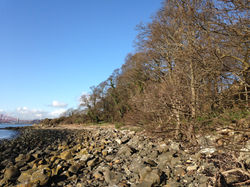Flying False Colours
We had quite a bonanza of late flowering alongside the path where we sowed seeds back in May of this year. A visit in late August when the border was in full sun and sheltered from a brisk west wind showed that it was a magnet for a wide range of insects. The majority of the flowers in bloom were Corn Marigold, with some white Scentless Mayweed and occasional Cornflower and Poppy. Behind, in the grass dominated area sown by the cub group in 2015, biennial Wild Carrot were also coming into flower.


Flowers of the daisy family have abundant pollen but rather less nectar, so though there were occasional bumblebees, they were few in number as they do not usually visit the open daisy type of flowers. More favoured flowers for this group of pollinators, such as the Black Knapweed and Scabius, are still too infrequent in our patch to satisfy demand. The dominant group of pollinators seen, especially on Corn Marigold, were various kinds of Hoverfly.
This group of insect gain some protection from predators by flying false colours and having the colour patterns usually seen on insects that sting, so black and yellow stripes, reminiscent of annoying wasps, appear to be particularly effective and are used by several species.
Most of the black and yellow ones feeding on the flowers are Syrphid hoverflies, principally Syrphus ribsii which in their larval stages are fierce predators of aphids and so are very useful in helping to keep greenfly under control in the garden, or in farmer’s fields. For this reason some farms have a border alongside their fields planted with flowers, such as the ones we have sown, in order to provide essential feeding stations for the adults.

There were however a few individuals of a species (Helophilus pendulus) displaying a different pattern of stripes, this time on the thorax, and earning its common name “The Footballer”. This is in a different group from the aphid eaters and its larvae live in stagnant pools rich in organic material, quite possibly in the sumps of our street drains, helping to keep them clean. This is a habitat also used by the other large group of Hoverflies, the Eristalids which, with their brownish colouration, are said to be mimics of Honey Bees. Individuals of the common species, Eristalis pertinax, were also visiting the flowers of the Wild Carrot.



Not all however are so benign, there were also a couple of much rarer insect species which have a very different lifestyle. One, a small solitary wasp an Ectminius species, probably E. cephalotes, was hanging around the flowers or perching on grasses waiting to catch and kill one of the hoverflies. This it would take back to its tubular nest burrow, usually in a rotting tree stump, where it would lay its egg and seal it up for its larva to feast on.

The other, even smaller, was a Thick-headed fly, probably Canopus quadrifasciatus, and this was also waiting in ambush, but this time for a bumblebee which it would grapple briefly in order to insert its egg into the bumblebee body and the larva which hatched would then complete its development inside this host. An inspiration for the film Alien perhaps?

Not all of nature is thus a pleasant story, but these observations indicate that we are beginning to see quite a wide diversity of species on our wildflower patch, and this is a sign of the value of what we have achieved with the wildflower planting we have done.
It is also worth comparing the two sides of this pathway. One side, managed for wildlife, the other for tidiness. If all was like the tidy side, our pollinators, which are declining over the country as a whole, and this includes the adults of those greenfly eaters, would have much further to travel to find food, and their numbers too would decline.


Managing an area for wild flowers, and the wildlife that needs them, may not be easy, but these observations suggest that the effort is worthwhile.
Dick Alderson







































